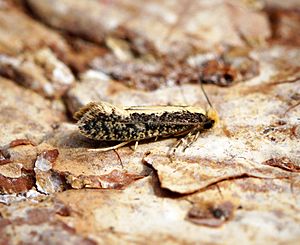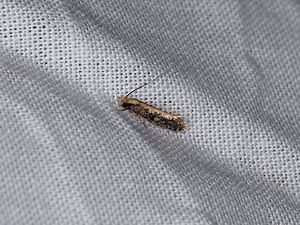Pale-backed clothes moth facts for kids
Quick facts for kids Pale-backed clothes moth |
|
|---|---|
 |
|
| Scientific classification | |
| Genus: |
Monopis
|
| Species: |
crocicapitella
|
| Synonyms | |
|
|
The Monopis crocicapitella, also known as the pale-backed clothes moth, is a small moth. It belongs to the Tineidae family, which includes many types of clothes moths. This moth was first described in 1859 by James Brackenridge Clemens.
You can find this moth almost anywhere in the world. It was first discovered in the eastern United States. The pale-backed clothes moth is known for causing damage to fabrics and clothing. Scientists have studied these moths to understand how they spread and how many there are. For example, a study in England showed that the number of these moths caught in traps increased over several years.
What the Pale-backed Clothes Moth Looks Like
This moth is quite small. Its wingspan is usually between 10 and 16 millimeters. That's about the length of your fingernail!
It looks a bit like another moth called Monopis obviella. However, the pale-backed clothes moth has less clear markings. Its back stripe is darker, and its front wings have more speckles. The hindwings (back wings) are a light whitish-grey or pale grey. In western Europe, you can usually see adult moths flying from June to October.
What the Larvae Eat
The young moths, called larvae, eat different kinds of dried animal and plant material. They have been found in many places. These include old debris, inside a dead rat, and in pigeon droppings.
Larvae also live in bird's nests. They can be found in stored foods like flour and corn. They also like felt. As their common name suggests, these larvae also feed on textiles. This means they can be very destructive to clothes and other fabrics.


